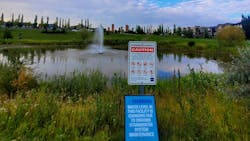Until it’s over the weir: Why healthy stormwater ponds protect our waterways
Key Highlights
- Regular maintenance such as dredging, shoreline stabilization, and control structure inspections is crucial to sustain pond treatment capacity and prevent pollutant export.
- Monitoring key parameters like dissolved oxygen, turbidity, and nutrient levels enables early detection of performance issues and guides targeted interventions.
- Retrofit options such as installing baffle walls, aeration systems, and native vegetation buffers can significantly improve older ponds' treatment efficiency without full reconstruction.
The quality of water leaving a stormwater pond; whether today, tomorrow or months from now carries direct implications for downstream water quality, regulatory compliance and infrastructure resilience. Every gallon discharged represents a complex matrix of sediments, nutrients, hydrocarbons and organic matter. When unmanaged, this outflow functions as a conveyor system for fertilizers, sediments, trash, oil, grease and emerging contaminants into creeks, rivers, wetlands and municipal drinking-water supplies.
Urbanization concentrates runoff from roofs, streets, parking lots and landscaped areas, funneling it into the pond. If the pond’s hydraulic and ecological functions are degraded; whether through lack of maintenance, poor design retrofits, or aging infrastructure, these pollutants accumulate and are eventually exported. Once water flows over the weir or through the outlet structure, everything it contains becomes part of the receiving water’s pollutant load. This is not a site-level aesthetic issue; it is a watershed-scale compliance and infrastructure issue with measurable downstream costs.
Stormwater ponds as passive but critical treatment assets
Unlike wastewater treatment plants, which operate under direct regulatory oversight with continuous operator adjustments and chemical treatment, stormwater ponds must achieve pollutant removal passively. Extended detention, often lasting twenty days or more, allows physical sedimentation, biological uptake, and chemical transformation processes to occur. A properly designed pond is engineered to slow hydraulic residence time, settle coarse and fine particles, facilitate microbial processing, and reduce nutrient and pollutant loads. It is effectively the front-end treatment unit of the municipal separate storm sewer system.
When routine maintenance lapses such as when forebay dredging is deferred, shoreline stability is compromised, or control structures are clogged; the pond’s treatment efficiency collapses. At that point, the facility ceases to function as a nutrient sink and becomes a nutrient source, increasing downstream pollutant loads. For municipalities subject to total maximum daily load (TMDL) allocations or MS4 permits, this can directly impact permit compliance and reporting obligations, increasing both financial and legal risk.
Understanding ecological and hydraulic dynamics
Stormwater ponds are hybrid hydraulic ecological systems. Below the surface, microbial communities, algae and benthic organisms continuously process incoming pollutant loads. Stable detention time allows particulate matter to settle in forebays and basins, while algae and rooted macrophytes absorb nutrients such as nitrogen and phosphorus. Microbial activity drives mineralization and nitrification and denitrification processes, while chemical reactions transform metals, hydrocarbons and other organic contaminants.
These processes are highly sensitive to loading rates. When upstream development, maintenance neglect, or poor vegetation management increases sediment and nutrient loading, the pond’s internal cycling capacity is exceeded. Oxygen depletion develops in bottom layers, and nutrients begin recycling from anoxic sediments. Harmful algal blooms may form, outlet structures clog, and downstream water quality deteriorates. When these dynamics go unmanaged, municipalities often face increased dredging frequency, higher downstream nutrient loads, and potential noncompliance with TMDL implementation plans.
The cost of deferred maintenance
Municipal stormwater infrastructure represents significant capital investment. When ponds are treated as ornamental amenities rather than engineered assets, maintenance is often delayed until major failures occur. Deferred maintenance leads to measurable consequences, including loss of storage capacity, which reduces flood mitigation effectiveness, and excessive sediment buildup that requires expensive dredging mobilizations. Vegetation becomes overgrown, clogging hydraulic conveyance pathways and increasing mosquito habitat, while structural components like risers, outfalls, and weirs may fail. Over time, these failures create regulatory liabilities due to illicit discharges or permit exceedances.
By contrast, programmatic maintenance costs are consistently lower than reactive dredging or retrofitting after years of neglect. Structured operations and maintenance programs that include forebay cleanouts, buffer management, outlet inspections, and hydraulic performance checks extend the functional lifespan of ponds and ensure that pollutant removal targets are consistently met. For municipalities, this approach translates into more predictable capital planning, fewer emergency mobilizations and stronger compliance posture.
Dissolved oxygen: A leading performance indicator
Dissolved oxygen is one of the most critical control parameters for stormwater pond functionality. Adequate oxygen levels sustain aerobic microbial processes responsible for nutrient cycling and organic matter degradation. When oxygen drops below approximately four milligrams per liter, treatment efficiency declines sharply, and nuisance conditions accelerate. This depletion often occurs because of high organic loads from leaf litter, grass clippings, or debris; elevated nutrient inflows that stimulate algal blooms; thermal stratification in deeper basins without mixing; and inadequate hydraulic circulation.
Engineering and operational controls can mitigate these risks. Diffused aeration or surface agitation systems destratify the water column and improve oxygen transfer. Hydraulic design optimization helps minimize stagnant zones where oxygen depletion can take hold. Targeted vegetation management maintains nutrient uptake capacity without causing nighttime oxygen crashes from respiration. Upstream source control measures such as fertilizer ordinances, buffer requirements, and sediment traps help reduce organic and nutrient inputs. Dissolved oxygen trends are often early indicators of declining pond health, surfacing problems before they become visually apparent. Incorporating dissolved oxygen monitoring into municipal maintenance programs enables early, cost-effective interventions.
Monitoring and data-driven O&M programs
While visual inspections provide quick insights, quantitative water quality monitoring is the most reliable method for evaluating pond performance. For municipalities, this is essential for MS4 permit compliance, TMDL implementation and long-term asset management. Key parameters to monitor include dissolved oxygen, turbidity and total suspended solids, nutrient concentrations, pH, temperature, and sediment accumulation rates. Dissolved oxygen values typically range from five to nine milligrams per liter at the surface in healthy systems, and levels should remain above four milligrams per liter even at dawn. Elevated turbidity indicates inefficient sediment capture, while high nutrient concentrations point to excess loading or internal cycling.
Tracking these parameters allows municipalities to identify performance declines before failures occur. Monitoring supports prioritization of dredging and retrofit schedules, documents pollutant load reductions for TMDL reporting, aligns maintenance budgets with actual treatment performance, and provides defensible data during regulatory audits. Incorporating automated sensors or seasonal grab sampling, linked with GIS asset management systems, transforms pond management from reactive to predictive and strategic.
Watershed integration and regulatory linkages
Stormwater ponds are not isolated systems. Their performance directly affects receiving streams, wetlands, reservoirs, and downstream drinking-water infrastructure. Neglected ponds increase pollutant loads that ultimately flow into regional water bodies already subject to regulatory pressure. In many jurisdictions, state and federal stormwater permits require documented operations and maintenance programs for best management practices, including ponds. Poor performance can contribute to exceedances of waste load allocations, triggering enforcement actions, fines or mandated retrofits.
By integrating stormwater ponds into municipal asset management and watershed-based planning frameworks, engineers can ensure that performance is consistent with MS4 permit requirements and aligned with TMDL load reduction goals. Proactive pond management also strengthens infrastructure resilience and improves coordination with upstream and downstream partners. Municipalities that incorporate these ponds into their larger watershed strategies significantly reduce liability exposure while improving their capacity to manage high-intensity rainfall events.
Engineering interventions and retrofit opportunities
Many ponds, especially those constructed decades ago, were not designed to meet modern stormwater quality standards. For municipalities managing aging infrastructure, targeted retrofits can dramatically improve performance without full reconstruction. For example, constructing or enlarging a forebay improves sediment capture and prolongs pond lifespan. Installing baffle walls or berms extends flow paths and increases detention time, enhancing treatment efficiency. Modifying low-flow orifices can optimize residence time for settling and nutrient processing. In-situ aeration or circulation systems maintain dissolved oxygen levels and minimize stagnation. Native plant buffers can stabilize shorelines while taking up nutrients, and floating wetland islands can further enhance pollutant removal capacity.
These types of retrofits, when paired with enhanced operations and maintenance, allow municipalities to bring older ponds into compliance with modern standards at a fraction of the cost of complete reconstruction.
Building sustainable O&M programs
Sustainable pond management requires institutionalized operations and maintenance frameworks rather than one-time cleanouts. A sound program begins with a comprehensive inventory of pond assets, documenting ownership, function, capacity and regulatory status. From there, municipalities develop inspection schedules that include both structural assessments and water quality checks. Regular sediment surveys establish baselines and help track accumulation rates to plan dredging cycles accurately. Budget forecasting ensures that funding is available for predictable maintenance rather than emergency expenditures. Field staff must be trained with standardized protocols to ensure inspections and maintenance activities are consistent and technically sound. Finally, coordination across departments; public works, utilities, stormwater programs, and regulatory agencies create operational alignment and prevents gaps in responsibility.
When these elements are in place, stormwater ponds remain functional treatment systems rather than deteriorating into unmanaged liabilities that increase downstream costs.
The financial and regulatory return on investment
For municipalities, healthy stormwater ponds generate tangible financial and regulatory benefits. Consistent maintenance and monitoring reduce dredging costs by allowing for early interventions, avoiding expensive emergency mobilizations. Proactive management lowers the likelihood of downstream impairment, minimizes regulatory enforcement risk and extends infrastructure lifespan. A well-maintained pond system also enhances flood mitigation capacity, reducing impacts during major storm events. In contrast, deferred maintenance often multiplies costs by a factor of three to five, as neglected facilities require major restoration rather than routine upkeep.
Municipalities that invest in pond health not only save money but also protect themselves from potential enforcement actions, TMDL noncompliance and reputational damage. Moreover, resilient stormwater infrastructure improves community safety and supports regional water quality goals.
From asset maintenance to watershed stewardship
For stormwater engineers, utility departments and municipal program managers, pond health is not simply a matter of routine upkeep. It is a strategic investment in watershed performance, regulatory compliance, and public infrastructure resilience. Aeration, vegetation control, debris management, hydraulic optimization, and monitoring must be viewed as essential components of modern stormwater programs.
When ponds are actively managed as treatment systems, pollutant loads decline, flooding impacts lessen, regulatory reporting becomes more defensible and long-term costs decrease. Downstream ecosystems and drinking-water sources benefit directly from these improvements. Stormwater ponds are not ornamental features; they are engineered treatment systems. And once water moves over the weir, the opportunity to manage that pollutant load is gone. Proactive maintenance, integrated planning and data-driven management are the foundation of sustainable municipal stormwater infrastructure.
About the Author
Joseph Garavelli
Joseph Garavelli is senior environmental consultant at Ecological Improvements where he focuses on erosion control and water quality.


